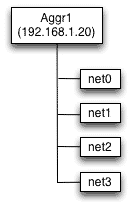How to Configure Link Aggregation in Solaris 11 (Trunk V/s Datalink multipathing (DLMP))
Link aggregations enable you to pool multiple datalink resources that you administer as a single unit. By combining the resources of the multiple datalinks and dedicating them to serving the system’s network operations, the system’s performance is greatly improved.
The image above shows an example of a link aggregation configured on a system, in which an aggregation aggr1 consists of 4 underlying datalinks, net0 through net3. These datalinks are dedicated to serving the traffic that traverses the system through the aggregation. The underlying links are hidden from external applications. Instead, the logical datalink aggr1 is accessible.
Link aggregation has the following features:
- Increased bandwidth: The capacity of multiple links is combined into one logical link.
- Automatic failover and failback: By supporting link-based failure detection, traffic from a failed link is failed over to other working links in the aggregation.
- Improved administration: All underlying links are administered as a single unit.
- Less drain on the network address pool: The entire aggregation can be assigned one IP address.
- Link protection: You can configure the datalink property that enables link protection for packets flowing through the aggregation.
- Resource management: Datalink properties for network resources as well as flow definitions enable you to regulate applications’ use of network resources.
Types of Link Aggregation
Trunk Aggregations
Trunk aggregations benefit a variety of networks with different traffic loads. For example, if a system in the network runs applications with distributed heavy traffic, you can dedicate a trunk aggregation to that application’s traffic to avail the increased bandwidth. For sites with limited IP address space that nevertheless require large amounts of bandwidth, you need only one IP address for a large aggregation of interfaces. For sites that need to hide the existence of internal interfaces, the IP address of the aggregation hides its interfaces from external applications.
In Oracle Solaris, when you create link aggregation, the aggregation is by default created in trunk mode. Typically, systems that are configured with link aggregations also use an external switch to connect to other systems.
Trunk aggregations also support back-to-back configuration. Instead of using a switch, two systems are directly connected together to run parallel aggregations. The most common application for back-to-back link aggregations is the configuration of mirrored database servers.
Datalink Multipathing (DLMP) Aggregations
A trunk aggregation generally suffices for the requirements of a network setup. You can span trunk aggregation to multiple switches but requires switch configuration and switch-vendor proprietary extensions to work. DLMP aggregations can span over multiple switches.
In a trunk aggregation, every port is associated with every configured datalink over the aggregation. In a DLMP aggregation, a port is associated with any of the aggregation’s configured datalinks as well as with the primary the interface and VNICs over that aggregation.
You can switch between a trunk aggregation and a DLMP aggregation by using the dladm modify-aggr command, provided that you use only the options supported by the specific type.
DLMP aggregation supports link-based and probe-based failure detection to ensure continuous availability of the network to send and receive traffic.
Creating a Trunk Aggregation
The example below shows the commands to create a link aggregation with two underlying datalinks, net0 and net1. The aggregation is also configured to transmit LACP packets. The example begins with the removal of existing IP interfaces over the underlying datalinks.
# ipadm show-if IFNAME CLASS STATE ACTIVE OVER lo0 loopback ok yes -- net0 ip ok no -- net1 ip ok no --
# ipadm delete-ip net0 # ipadm delete-ip net1
# dladm create-aggr -L active -l net0 -l net1 aggr0
# dladm show-aggr LINK MODE POLICY ADDRPOLICY LACPACTIVITY LACPTIMER aggr0 trunk L4 auto active start
Creating a DLMP Aggregation
The example below shows how to create a DLMP aggregation. The aggregation has four underlying datalinks.
# dladm create-aggr –m dlmp -l net0 -l net1 -l net2 -l net3 speedway0
# dladm show-link LINK CLASS MTU STATE OVER net0 phys 1500 up -- net1 phys 1500 up -- net2 phys 1500 up -- net3 phys 1500 up -- speedway0 aggr 1500 up net0 net1 net2 net3
# dladm show-aggr LINK MODE POLICY ADDRPOLICY LACPACTIVITY LACPTIMER speedway0 DLMP -- -- -- --
Configuring Probe-Based Failure Detection for DLMP Aggregation
The example below shows how to configure probe-based failure detection for a DLMP aggregation.
# dladm show-aggr LINK MODE POLICY ADDRPOLICY LACPACTIVITY LACPTIMER speedway0 DLMP -- -- -- --
# dladm set-linkprop –p probe-ip=+ speedway0 # dladm set-linkprop –p probe-fdt=15 speedway0
# dladm show-linkprop –p probe-ip,probe-fdt speedway0 LINK PROPERTY PERM VALUE EFFECTIVE DEFAULT POSSIBLE speedway0 probe-ip rw + + -- -- speedway0 probe-fdt rw 15 15 10 1-600


No comments:
Post a Comment